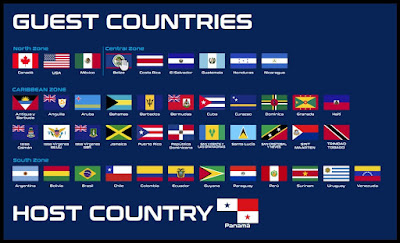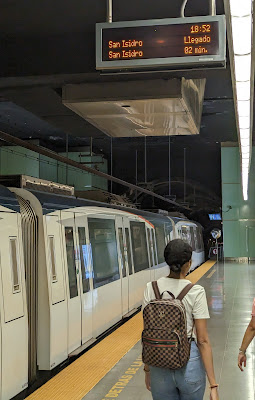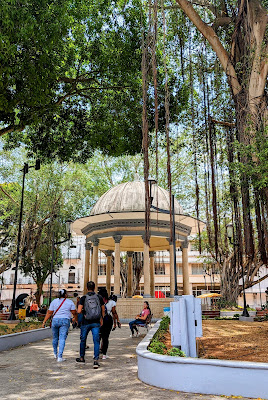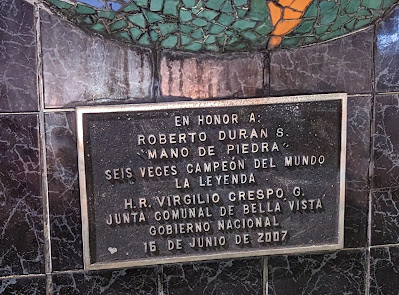As most of you know, I am enjoying a healthy mix of private trips and reimbursed travel, often to international destinations. So when I was offered the chance to fly to Panama City to be part of this year's Continental Championships (as the Pan-Ams are also known) I didn't hesitate a second to accept. Of course, with this assignment coming just days after my return from Barcelona I had to be organized to pull things off without getting too frazzled. So, before I even left for Spain I had already packed 95% of what I needed for my trip to the isthmus. Thank goodness I have a lot of bags, underwear, shirts, and socks!
 |
| Podium shot of the U23 Men |
 |
| Playing tourist |
Reaching Panama City coming from Lubbock in one day is, at least currently, impossible if you fly American Airlines. United offers a flight via Houston that does not require an overnight stay, but that fare was somewhat higher and of course I'm an AA guy who continually chases status for the upcoming year. The least expensive hotel that I could find at the Miami airport was a Sonesta property, $50 less than a La Quinta (!!!)—and even then the bill still came to around $170 with tax! Whew, but I'll get reimbursed, and with this stay I was able to extend my expiring Sonesta points by another 24 months. I tell you, good planning is essential when it comes to points and miles.
 |
| Sunday morning breakfast in the Admirals Club |
 |
| Judy always loved the floor of the concourses in MIA |
So, once again I was going to spend the better part of a day in two airplanes and a lounge before reaching the Sonesta; the next day I didn't fly out until noon, so things weren't too hectic. Once I got to PTY, as Panama City's
Aeropuerto Internacional de Tocumen is coded, I didn't have to wait long until a driver from the organizing committee showed up. Around the same time the rather large Colombian delegation of riders, coaches, docs,
soigneurs, and various federation representatives arrived as well, and my driver had to organize their bus transfer while I sat in the non-air-conditioned car for about an hour. Well, that really could have been done a little better, I thought, but the logistics of putting on an event with 44 invited countries and a budget of close to a quarter million is not an easy feat.
 |
| The daily bus transfer for the racers from the hotel to the venue |
The drive to downtown Panama City took about 45 minutes, and I was surprised by the impressive skyline of the modern city. I had visited Panama only once before, back in 1979 when I rode my bike from Texas to the Panama Canal, and quite frankly, there isn't much recollection of what I saw back then. As I would find out over the course of the next week, Panama City has about 4 million inhabitants and, as we all know, is an important commercial (and of course banking) epicenter for all of Central America, if not beyond. The skyscrapers are testimony to the presence of large corporations and big money; at the same time, the city features the same run-down areas and
favelas that most similar cities in Central and South America (indeed, around the world) are known for.
The host hotel for the championships was the Hotel El Panama By Faranda Grand, part of the Radisson group. The self-anointed five-star hotel bills itself as
El Primer Hotel en Panama, but I can't say that it really lives up to that billing. Not only had the hotel lost my reservation (and it took yet another hour of waiting to finally be able to check into what supposedly was the last available room), but if you looked too closely the general appearance of the El Panama was a bit on the tired side. Give it three-and-a-half stars, but please don't think
cinco estrellas! But let's put aside first-world attitudes: I am sure that for the riders from Haiti and the Dominican Republic this hotel must have appeared like heaven!
 |
| Our hotel's pool and the view from my window |
 |
Bicycles, bicycles, bicycles that all need to be assembled
and later once again packed |
While the hotel was situated in the bustling modern part of downtown Panama City, the race venue was approximately 30 to 45 minutes away, depending on the time of day and traffic patterns. Panama City has a real issue with clogged highways during rush hour, and I experienced that firsthand on Monday afternoon when my driver for the week, Abdiel, picked me up at the hotel so I could inspect my work environment ahead of the start of the competition on Tuesday. Just like in the US, people live outside of the city and have to commute every morning into and every afternoon out of the metropolitan heart, clogging up even six-lane arteries.
 |
| Morning rush hour, on the opposite side |
 |
Two containers next to the gasolinera Terpel
were my workstation for the week |
Fortunately, those traffic patterns on Monday afternoon were reverse from what we faced during the week of racing. Imagine 300+ racers, staff, and all of their equipment being shuttled by large buses and team cars from the hotel to the venue. Since racing started at 9:00 a.m., the exodus from the hotel started at 6:00 a.m.. It was quite the sight. Abdiel would pick me up at 6:30 a.m. in the Shimano neutral support car, with a mechanic, wheels, a styrofoam cooler, and my pull-along with my equipment stuffed into the back. In the afternoons, once I was done with my work which could be as late as 7:00 p.m., Abdiel and the mechanic would be patiently waiting for me to drive me back home, their part of the day having ended an hour or more before I finally could close shop. We did this on five days as Tuesday and Wednesday were reserved for the individual time trials for the Junior, U23, and Elite men and women, separated by a rest day from the Friday, Saturday, and Sunday road races for the same categories. It was a full schedule!

 |
| Some of the commissaires waiting for their ride |
 |
| Abdiel and the diminutive mechanic getting ready to load the neutral bikes |
 |
| The daily commute |
All the races took place on a closed-off out-and-back divided two-lane highway; the circuit for the road races measured almost 13K, so that the Elite Men ended up doing 16 laps for their 205K race, which took almost five hours to complete. The brutal heat that around noon hit the low 90s with an even higher percentage of humidity, plus the constantly undulating course, took their toll on the riders. Staying hydrated was paramount, and just finishing, I thought, was an extraordinary feat. The Junior road races for both the men and women took more than three hours! Murderous!
Fortunately, my crew and I were working out of two air-conditioned containers, so we got hit by the heat only when we ventured outside. Of course, I
did spend quite a bit of time at the line, watching the racing action for obvious reasons. On Saturday, the race's Chief Referee, Elaine from Brazil, took me along in the commissaire car and I got an inside view of the race action. BTW, there were some other commissaires whom I had met at prior years' races, and it is always fun to be part of this great tribe that we have, regardless of our job function.
 |
| Elaine in action |
My local colleagues Diana, Julio, and Paula made sure that our part of the PanAms ran smoothly and without drama and fanfare. It is rare to have as much support as I did at this race, and it made my life so much easier! When we finally parted ways at the conclusion of our work after the Elite Men's race, we parted as friends. I fully expect to stay in contact with Diana, the way I still exchange notes with Gino from Lima and my very favorite Uruguayan, Gabriel.
 |
| Julio with the sombrero and Diana and Paula on the right |
 |
| Daily lunch |
 |
| Solangel working on her selfie skills |
 |
| No, they were not part of our crew! |
 |
| The VIP section on the grandstand |
So, that was the race part, which paid the bill. But of course, there's
free time at any race, and I tried to make good use of mine. As I said, Thursday was a rest day (or better, a transition day from the time trials to the road races) and that gave me a chance for some extended sightseeing. Unfortunately, Monday (the day before competition began) had been a bit of a dud because the organizing committee was just so overwhelmed with arriving delegations that it was difficult to do any decent planning. I had thought that I'd have only a couple of free hours on the day after my arrival, but as it turned out, I would have had pretty much the entire day to do something different than going for a quick two-hour walk and then hang by the pool.

On Thursday, though, I had no race obligations, and after doing a bit of Googling I knew what I was going to do: take the metro to the
Casco Viejo and explore old Panama City! Now, the subway in this city is by far not as sprawling as what you'd find in London, Paris, New York, or Berlin, but there are two intersecting lines, and one of the stations,
Iglesia del Carmen, was mere steps from the hotel. When I couldn't figure out how to buy a single ticket with my credit card and turned to one of the many friendly metro hosts I found out that you simply use your credit card at the turnstile! Wow! I've never seen that, anywhere. Nope, you don't get a receipt, and if it hadn't been for the Rome2Rio app I wouldn't have had any idea of what the approximate price might be—as I just found out this morning when checking my German CC account the price came to $0.32 per ride. OK, I take that!

The
Casco Viejo is definitely different from the modern part of the city. It's what you'd expect to see in Central America: vibrant street life with vendors everywhere, narrow streets, clogged and honking traffic, people milling around going after their everyday lives. School children in their freshly pressed uniforms (reminding me of my old friend Danny, with whom I attended Texas Tech and who hailed from Panama) milling around their schools, an old shoeshine man working on a just-as-elderly client's footwear, two women with umbrellas (the true sense of the word means
shade giver) exchanging the latest gossip, and young man pulling a few fish out of a plastic bucket and being an impromptu fish monger.
Pura vida.
 |
| Two Guna women, an indigenous people who still live in the Darien region |
 |
| Open-air barber shop |
 |
| Molas, a Guna artform |
I let myself drift and took in the scenes, the smells, the sounds, the sights. Yes, I had come for the race, but let's be honest, that's why I had
really come down here. Ah, what lucky man I am to continue to take in all this beauty and paired with abysmal poverty and yet strumming with life. I feel comfortable in places like this, making up little stories in my head based on what I see, trying to imagine what goes through the protagonists' minds, motivates them, makes them happy, makes them sad.
Somehow I ended up at the tiny Museum of Modern Art. It would be easy to dismiss this place as unimportant, with something like maybe six to eight room, on two floors in a small colonial building. But let me tell you, the photographs of old Panama City, the stories behind the LGBTQ individuals living in a maybe not-so-emancipated environment, the sounds from the Darien and slides showing the indigenous people—45 minutes well spent!
There were other museums in the old town. One of them was the Museum of Panamanian History on the ground floor of the Municipal Palace of Panama City, yet another beautiful colonial building on
the main square, the
Plaza Catedral. There were even fewer rooms than in the MoM, yet being admitted (free entrance for all) required my full name, address, age, and time I would spend in Panama, all carefully recorded into a large leger by a timeless matron who exuded dignity.
The
Plaza Catedral is, quite obviously, home to the main church of PC. It's a small square, nothing really impressive, yet it would be even smaller if it hadn't been for one of the obligatory fires that decimated so many towns of those days. Let's rebuild, and while we're at it, let's enlarge the square by another two blocks. Voilá!
Just steps away is the Panama Canal Museum, and I
really wanted to see it. I spent probably an hour-and-a-half in this well-curated museum that chronicles the makings of the canal from the times of the early Spanish explorers all the way to its hand-over by the USA on the last day of the year 1999. Fascinating is an overused word, of course, but the tumultuous history of this waterway is interesting beyond imagination. Unfortunately I did not get a chance to go out to the Miraflores Locks on this trip, so I'll have to return one of these days.
 |
| Old lighthouse lens |
The
Casco Viejo (also known as
Casco Antiguo) with all its historic buildings, squares, and narrow streets is a definite tourist attraction. While some of the buildings have been restored to their original grandeur, much money is needed to repair and even rebuild some of the dilapidated homes and offices. The entire area has been named a UNESCO Cultural World Heritage Site (one of about 1,600 in 167 countries, BTW), but that doesn't mean that the needed funding is readily available. Walking through old Panama City (actually, the really
old old Panama City had been established a dozen or so miles away but was relocated after being devastated by the British pirate Henry Morgan back in 1671) feels like visiting a tropical New Orleans as many architectural traits are similar if not identical. I certainly enjoyed my day off.
I don't really know how to segue from the
Casco Viejo to Panama's equivalent of the Guatemalan
chicken buses, but I need to fit them in somewhere, so humor me. They're certainly not as abundant in the city as they were in Guatemala, but they definitely
do exist. And they're just as colorful! Just a few hundred meters from the race venue I found a chop shop that was working on a couple of buses, and I just couldn't help taking a few pics.
The Hotel El Panama is located in an area that is easily walkable and appears relatively safe at night—wide streets and sidewalks, lots of lighting, a fair number of pedestrians. Still, more than one Lady of the Night greeted me with a phony
Hi Baby!, and we all know that there must be other, darker elements around. I felt fine exploring the 'hood in the hours after getting done with my work and before dinner in the hotel. Luckily, half a dozen micro-breweries and taprooms can be found within a mile-and-a-half radius, and so I spent my early evenings sampling the local IPAs. All the beers were OK, with
Cerveceria Legitima serving up the nicest brew, but none were coming close to knocking off my socks. At
Animal Brew, a tiny place open only on the weekends, I had a chance to talk to owner and brewer Ricardo for a while. Fun.
 |
| Dinner in the hotel |
On my last night in Panama, after all the racing action was done and responsibilities had been lifted off my shoulders, I visited a small
cevicheria that had caught my eye on one of my evening walks.
Cholo Grill is an unassuming restaurant that specializes in
ceviche and burgers, and on Sunday nights there's live music, as I had observed a week earlier after my arrival. What better way to satisfy my craving for fresh
mariscos and an ice-cold Balboa or two and soak in local culture? I was not disappointed. When I arrived, the band was already jamming away with multiple male singers crooning away,
norteño style. But this was no Mexican music (who has ever seen a harp in a Mexican band?), and when I asked the server whether this was a Panamanian style of music he responded that the band was from Venezuela. With two or three 15- to 20-minute-long songs they had the local diners on their feet, dancing and offering cold ones to the band. It was quite the show and a befitting way to conclude this trip.
On Monday morning, the Panamanian cycling federation's technical director and de-facto race director, Juan Pablo Villegas (a successful ex-pro racer from Colombia), took me to the airport, and after an entire week of brief interactions we got to know one another so much better during this 40-minute ride. If there's a regret on my part it is that we didn't have a chance to connect on this personal level before, but who knows, maybe one of these days I will get a chance to see him in his hometown close to Medellin.
With a couple of hours of spare lounge time until my flight to Miami and onward I finished all my paperwork for the week, and then it was just a question of enjoying upgraded flights back to Lubbock, where I arrived, dead tired but rather happy, a few minutes before midnight. Another good trip was in the books.
Jürgen














































































































































